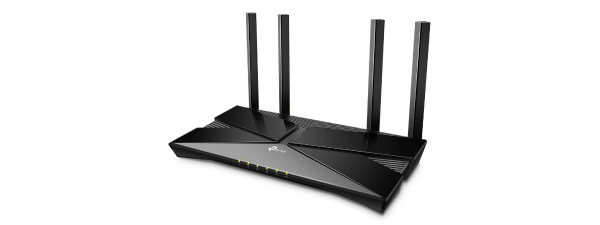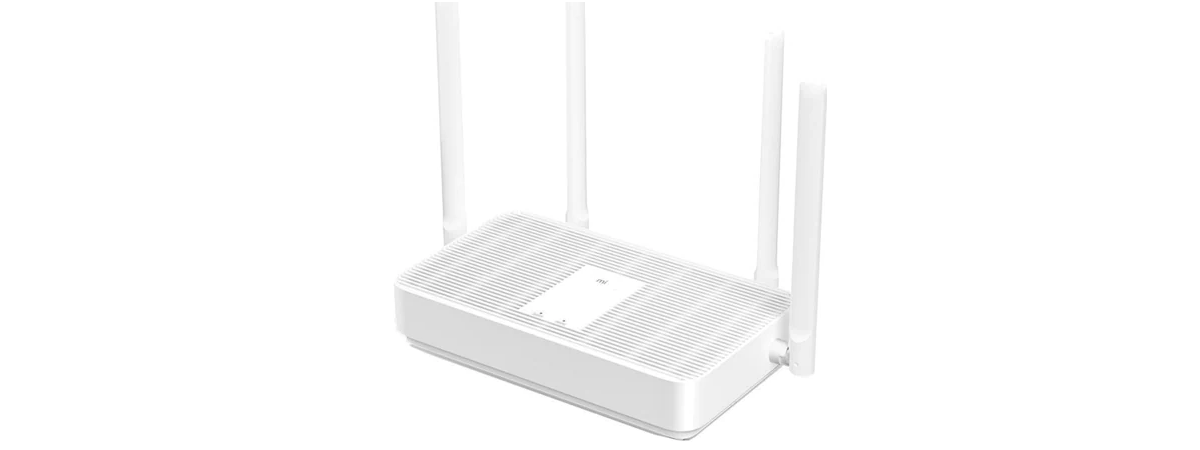
Wireless network performance
First, let’s look at the apartment used in our testing and how it is set up. Mercusys MR70X is placed in the living room. With most wireless routers, the signal strength is not great in places like the Kitchen and the Medium balcony.
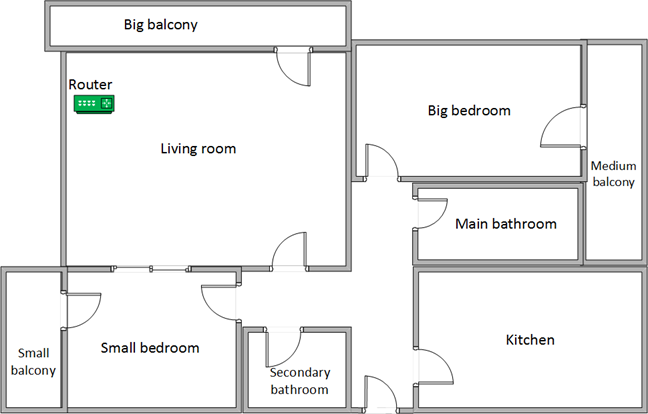
The apartment in which we tested Mercusys MR70X
Our testing was done using a fast 1 Gigabit Internet connection, capable of uploads on the internet of up to 800 Mbps. We evaluated the Wi-Fi emitted by Mercusys MR70X using the following standards: Wi-Fi 4 on the 2.4 GHz band, Wi-Fi 5, and Wi-Fi 6 on the 5 GHz band.
To get a better idea of the performance offered by Mercusys MR70X, we compared it with TP-Link Archer AX10 and NETGEAR Nighthawk AX4. We analyzed the 2.4 GHz band first when using the Wi-Fi 4 standard, and we measured the signal strength with NetSpot. You can see its evolution in the graphic below. Mercusys MR70X offered solid signal strength almost everywhere in our apartment.
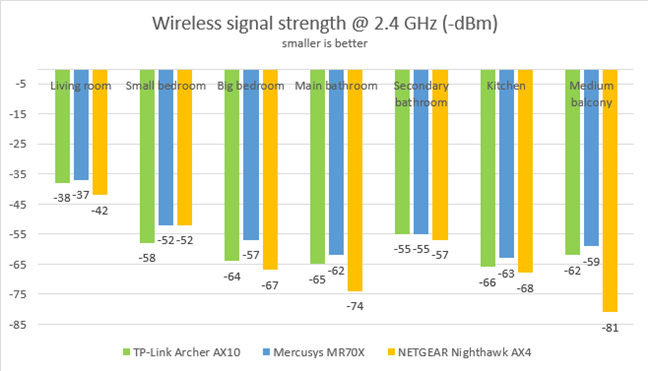
Mercusys MR70X - Signal strength on the 2.4 GHz band
Then, we wanted to see how fast the internet connection is when using the Wi-Fi 4 standard. We used SpeedTest on our laptop and made several measurements in each room. Mercusys MR70X was faster than the routers we compared it to in all rooms.
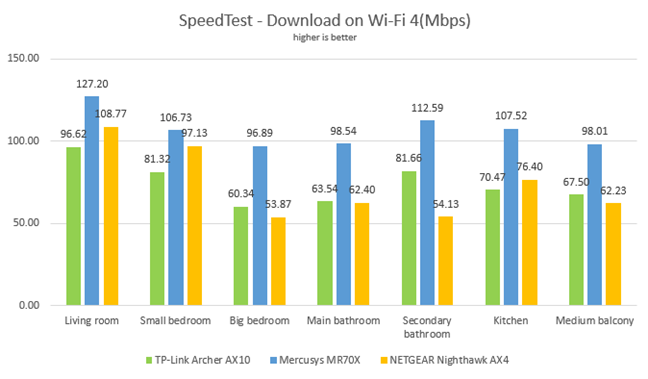
Mercusys MR70X - Downloads in SpeedTest on Wi-Fi 4
The same happened when measuring the upload speed too.
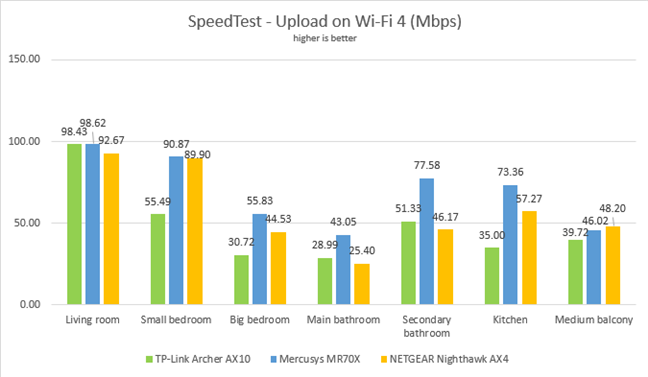
Mercusys MR70X - Uploads in SpeedTest on Wi-Fi 4
We used the PassMark Performance test to transfer data between two computers connected to the network on the 2.4 GHz band when using Wi-Fi 4. Mercusys MR70X performed well in all rooms, but TP-Link Archer AX10 was slightly faster in some rooms.
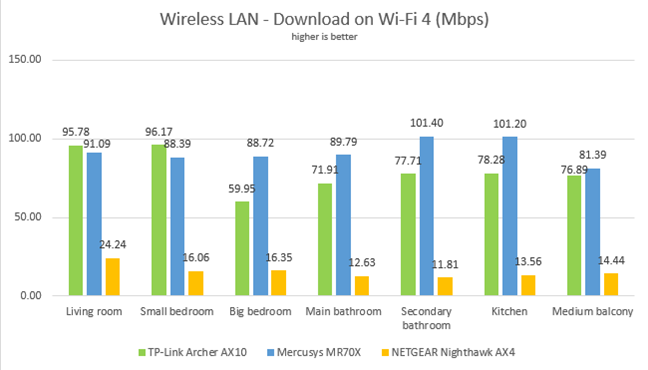
Mercusys MR70X - Network downloads on Wi-Fi 4
When measuring the upload speed, things were somewhat mixed, with no router being a clear winner in this comparison.
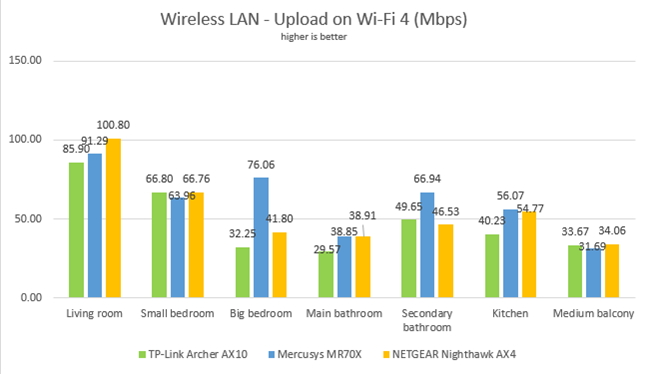
Mercusys MR70X - Network uploads on Wi-Fi 4
On the 2.4 GHz band, when using the Wi-Fi 4 standard, Mercusys MR70X performs well, beating the expectations we had, based on its affordable price.
For the next set of measurements, we analyzed the performance of the 5GHz wireless band using Wi-Fi 5. We looked at the evolution of the signal strength from room to room. The signal strength offered by Mercusys MR70X was similar to that of other routers.
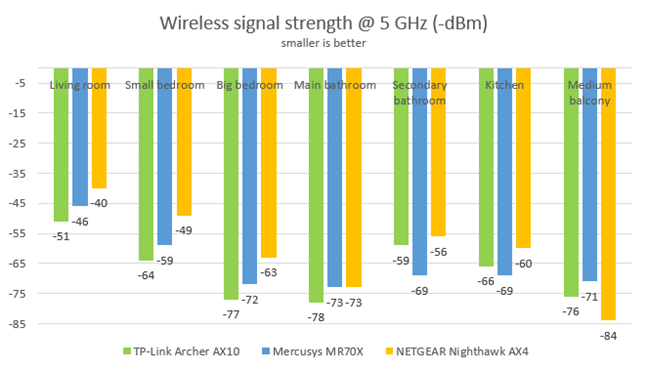
Mercusys MR70X - Signal strength on the 5 GHz band
We used SpeedTest to measure the speed of the internet connection when connected to the 5 GHz band when using the Wi-Fi 5 standard. In some rooms, Mercusys MR70X delivered the fastest downloads in our comparison.
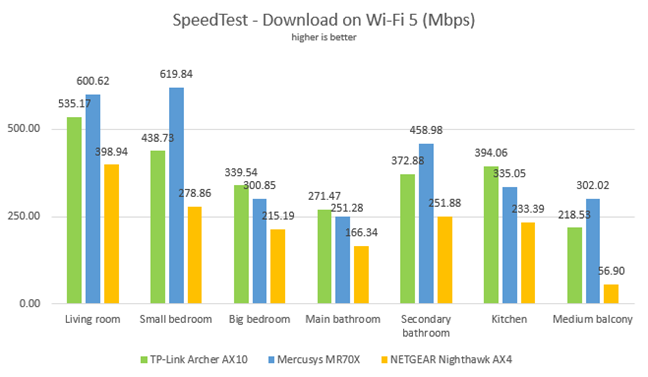
Mercusys MR70X - Downloads in SpeedTest on Wi-Fi 5
The same happened when measuring the upload speed too.
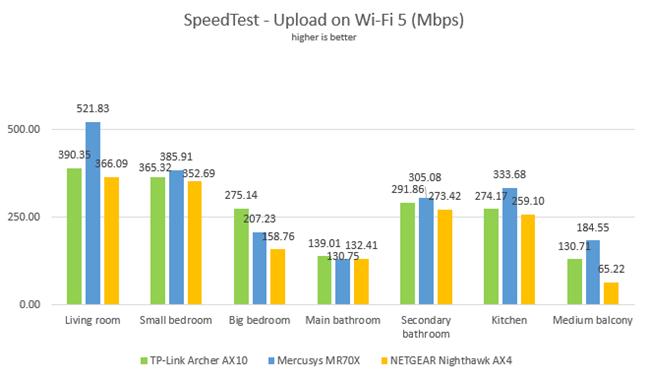
Mercusys MR70X - Uploads in SpeedTest on Wi-Fi 5
We then used the PassMark Performance test to transfer data between two computers connected to the network using Wi-Fi 5. Mercusys MR70X performed well in most rooms.
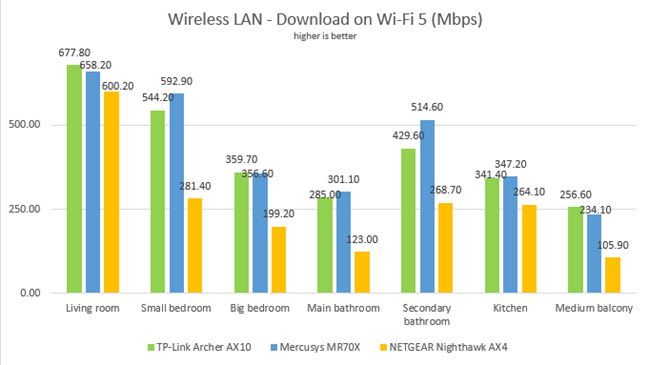
Mercusys MR70X - Network downloads on Wi-Fi 5
Just like with other routers, the uploads were not as fast as the downloads.
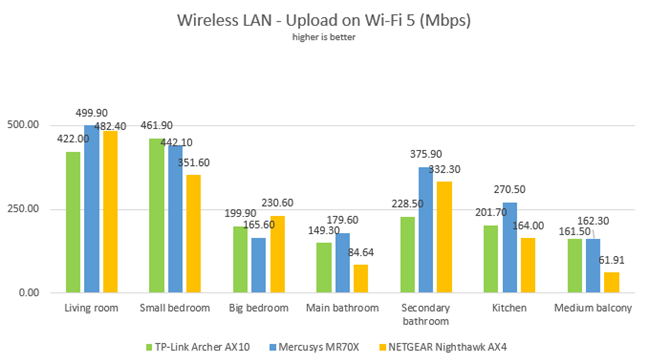
Mercusys MR70X - Network uploads on Wi-Fi 5
When using the 5 GHz band and the Wi-Fi 5 standard, Mercusys MR70X performs well and delivers the speeds you expect.
We remained on the 5 GHz wireless band, but we switched to using the Wi-Fi 6 standard. We first used SpeedTest to see how fast the internet connection is when using this standard. Unfortunately, when reviewing NETGEAR Nighthawk AX4, we did not have the necessary Wi-Fi 6 equipment to make measurements with this standard. Therefore, we compared Mercusys MR70X only with TP-Link Archer AX10. As you can see below, Mercusys MR70X tended to be slightly faster in most rooms.
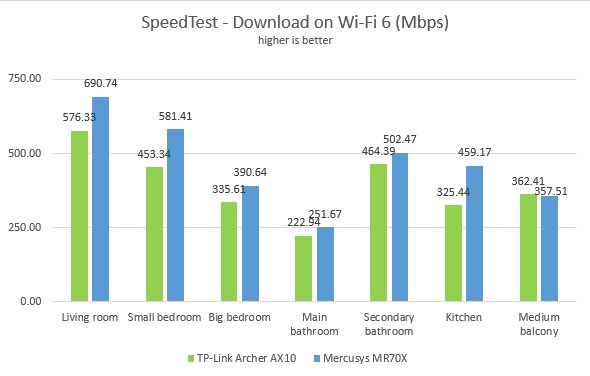
Mercusys MR70X - Downloads in SpeedTest on Wi-Fi 6
When measuring the upload speed, Mercusys MR70X was again faster, in most rooms.
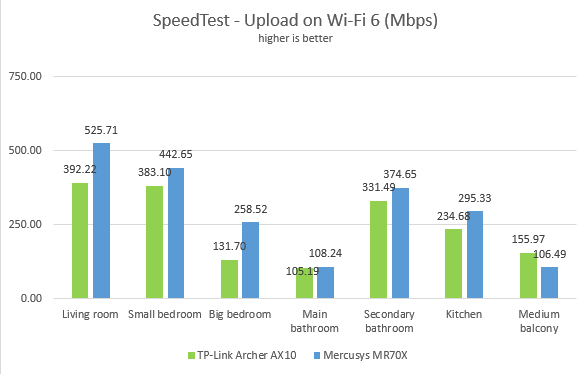
Mercusys MR70X - Uploads in SpeedTest on Wi-Fi 6
For the last round of comparisons, we used the PassMark Performance test to transfer data between two computers connected to the network using Wi-Fi 6. Mercusys MR70X delivered super-fast downloads in the room where it was placed.
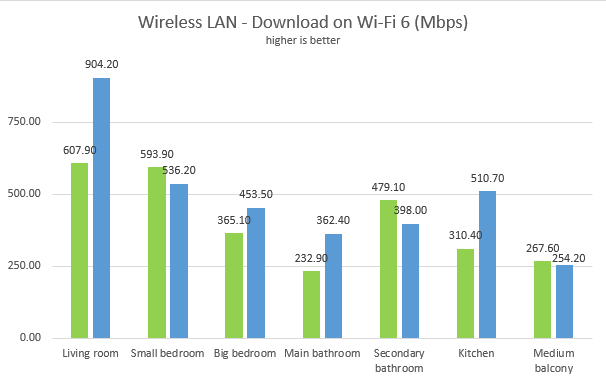
Mercusys MR70X - Network downloads on Wi-Fi 6
Unfortunately, uploads were sometimes on the slow side of things for both routers in our comparison.
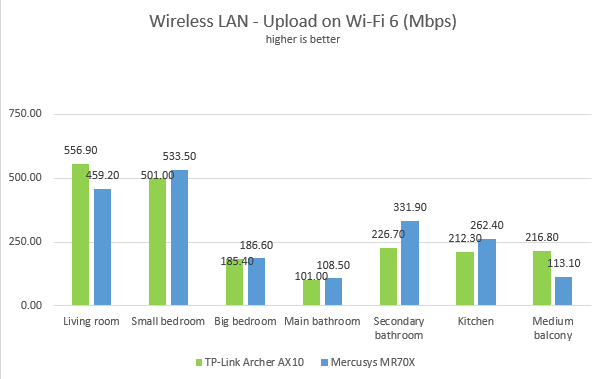
Mercusys MR70X - Network uploads on Wi-Fi 6
When using Wi-Fi 6, Mercusys MR70X performs well, similar to other routers in the same price range.
Wired network performance
Our internet connection offers a maximum of 1 Gbps for the download speed and 800 Mbps for the upload. Testing networking performance on Ethernet ports rarely provides any surprises. Most routers can easily match these maximum speeds or get very close to them. However, we always perform these measurements because, for some routers, we might notice some interesting facts. This was also the case with Mercusys MR70X.
We first used SpeedTest to see if this router can reach the maximum potential of our connection. As you can see below, Mercusys MR70X reached a maximum of 826.35 Mbps for the download speed, which is a bit underwhelming. This proves the fact that this router isn’t the best option for 1 Gbps internet connections. However, most people don’t have more than 500 Mbps available, which makes this a non-issue for them.
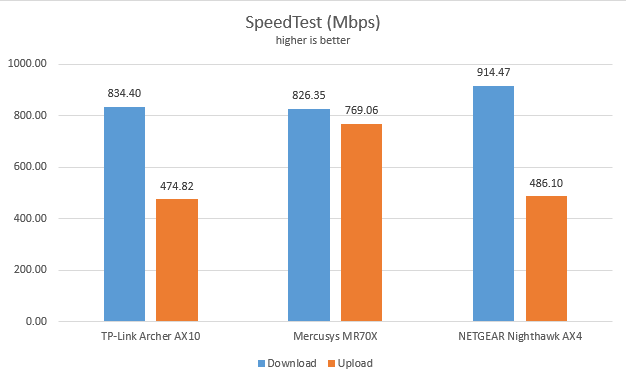
Mercusys MR70X - SpeedTest on Ethernet connections
One thing to note is that both TP-Link Archer AX10 and NETGEAR Nighthawk AX4 offered a lower upload speed because, when we reviewed them, our internet connection was capped at 500 Mbps for the upload.
Then, we ran a network transfer between two computers using the PassMark Performance test. This time, Mercusys MR70X had no problems getting close to the 1 Gbps promised in its specifications.
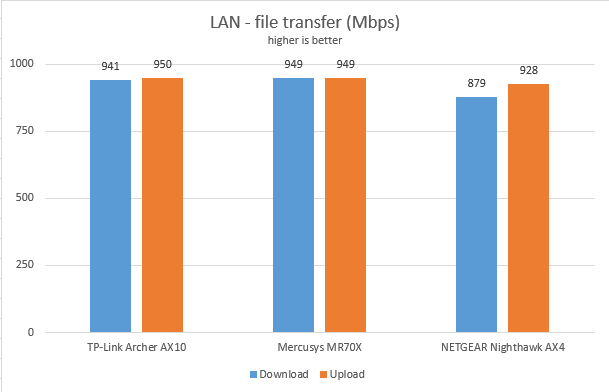
Mercusys MR70X - Network transfers on Ethernet connections
Our testing on Ethernet connections showed that Mercusys MR70X could not fully utilize 1 Gbps internet connections. It is a good match, though, for internet connections up to 850 Mbps.
Extra features
The firmware on the Mercusys MR70X includes plenty of useful configuration options, but it doesn’t have many advanced features. However, considering that it is an affordable router, this isn’t surprising at all. Here are the more advanced features available on the Mercusys MR70X AX1800 dual-band Wi-Fi 6 router:
- Dynamic DNS - allows you to connect to the router from the internet, even if your internet provider assigns you a dynamic public IP address. Mercusys MR70X works using the NO-IP and DynDNS services.
- Guest Network - you can enable guest Wi-Fi networks with individual security and access settings, one on each band (2.4 GHz and 5 GHz).
- Wireless schedule - you can set when you want the Wi-Fi to be turned off. Maybe you don’t want it on when you sleep or on the days you are not home.
- WDS Bridging - enables you to use two Mercusys wireless routers to extend your Wi-Fi network’s coverage area.
- Parental Controls - a simple set of parental controls that need plenty of manual configuration. With them, you can block all websites that contain a specific keyword, set daily time limits for the total time spent online by your children, or block a person's internet access between certain times.
- QoS - a basic Quality of Service feature that helps you control how the total bandwidth is split between devices and allows you to set which devices get priority.
- VPN Server - you can set your Mercusys router to work as a VPN server using the OpenVPN and PPTP protocols.
- IPv6 - support for IPv6 addresses that are going to replace IPv4. Our internet connection works with IPv6, and the router handled it well.
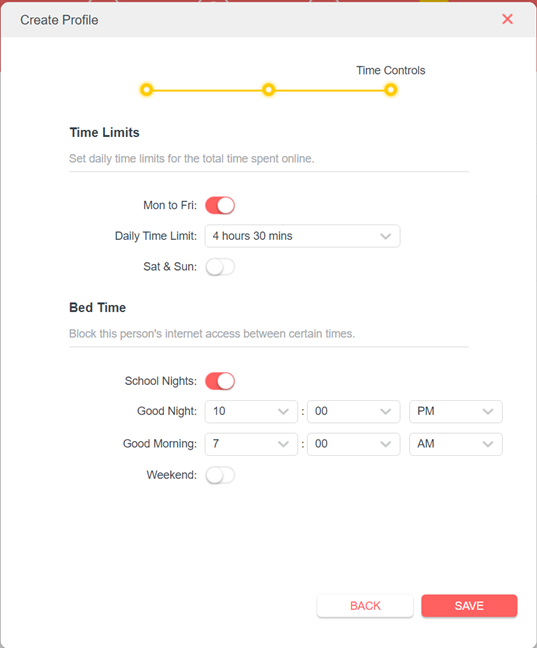
Partental controls on Mercusys MR70X
Mercusys MR70X covers the basics casual users need from their wireless router. However, one feature we would have loved it to have is automatic firmware updates. Unfortunately, you must manually download the new firmware from Mercusys’s support site and manually upload it to your router. This is a cumbersome process, and most users won’t do it, meaning that they don’t get the latest improvements and the best security for their router.
What is your opinion about the Mercusys MR70X AX1800 dual-band WiFi 6 router?
Now you know our opinion about the Mercusys MR70X0 dual-band Wi-Fi 6 router and how it performed in our testing. Before closing this review, tell us your opinion about this model. If you have it already, what is your experience so far? Comment below, and let’s discuss.


 23.03.2021
23.03.2021 